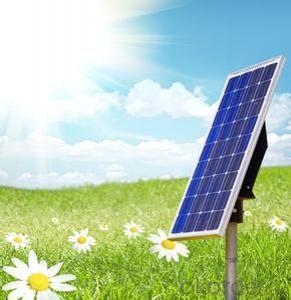Monocrystalline Silicon solar cell 20W
- Loading Port:
- China Main Port
- Payment Terms:
- TT OR LC
- Min Order Qty:
- -
- Supply Capability:
- -
OKorder Service Pledge
OKorder Financial Service
You Might Also Like
Quick Details
| Place of Origin: | Brand Name: | Model Number: | |||
| Material: | Size: | Number of Cells: | |||
| Max. Power: |
Packaging & Delivery
| Packaging Detail: | general packing |
| Delivery Detail: | 20 days |
Specifications
solar cell
1. Different types:Mini, Round, Small, Big
2. Monocrystalline silicon
3. Polycrystalline silicon
4. High quilit
Mini monocrystalline silicon solar cell
PV cell
power: 20w
size:340*290*23mm
weight:1.5kg
FEATURES:
1,High module conversion efficiency, through superior manufacturing technology .
2,Guaranteed -1% to +3% power tolerance .
3,Entire module certificated to withstand high wind loads and snow loads .
4,Anodized alumimum is mainly for improving corrosion resistance .
5,Highly transparent , low-iron , tempered glass and antireflective coating
6,Excellent performance under low light environments .
Benefits:
1,5 years warranty on materials and workmanship and 10 years warranty on power output .
2,Product liability insurance .
3,Enhanced design for easy installation and long tern reliaili
- Q:Can solar cells be used for desalination purposes?
- Yes, solar cells can be used for desalination purposes. Solar-powered desalination systems, such as solar stills and solar desalination plants, harness the energy from the sun to power the desalination process. This renewable energy source helps reduce the environmental impact of desalination and promotes sustainable water production.
- Q:How do solar cells perform in different geographical locations?
- Solar cells perform differently in different geographical locations due to variations in sunlight intensity, duration, and angle of incidence. Generally, solar cells perform better in regions with abundant sunlight and longer daylight hours, such as equatorial regions, deserts, and areas with minimal cloud cover. However, solar cells can still generate electricity in less sunny locations, albeit with reduced efficiency. Factors like temperature, air pollution, and shading from trees or buildings can also affect solar cell performance. Overall, the geographical location plays a crucial role in determining the energy output and effectiveness of solar cells.
- Q:Are there any subsidies or incentives for installing solar cells?
- Yes, there are various subsidies and incentives available for installing solar cells. These can include federal tax credits, state and local incentives, grants, and rebates. These measures aim to promote the adoption of solar energy and make it more affordable for individuals and businesses to invest in solar panel installations.
- Q:Can solar cells be integrated into building materials?
- Yes, solar cells can be integrated into building materials. Building-integrated photovoltaics (BIPV) is a growing trend where solar cells are embedded into roofing materials, windows, facades, and other building components. This integration allows for the generation of electricity while maintaining the aesthetics and functionality of the building.
- Q:How do solar cells perform in areas with high levels of vibration?
- Solar cells generally perform well in areas with high levels of vibration. The cells are designed to be sturdy and resistant to vibrations, ensuring their longevity and efficiency. However, it is essential to ensure proper installation and maintenance to minimize any potential damage or displacement caused by excessive vibrations.
- Q:Can solar cells be used to power water pumps or irrigation systems?
- Yes, solar cells can be used to power water pumps or irrigation systems. Solar panels can convert sunlight into electricity, which can then be used to power water pumps or irrigation systems. This is a sustainable and environmentally friendly solution as it relies on renewable energy sources.
- Q:What is the cost of producing a solar cell?
- The cost of producing a solar cell can vary depending on several factors such as the type and quality of materials used, the manufacturing process, and economies of scale. However, on average, the cost of producing a solar cell ranges from $0.20 to $0.70 per watt.
- Q:What is a multi-junction solar cell?
- A multi-junction solar cell is a type of solar cell that is composed of multiple layers of semiconductor materials, each with a different energy bandgap. This allows the cell to efficiently capture a wider range of solar radiation by converting different wavelengths of light into electricity. Hence, multi-junction solar cells can achieve higher conversion efficiencies compared to traditional single-junction solar cells.
- Q:Can solar cells be used in parking lots?
- Yes, solar cells can be used in parking lots. Solar panels can be installed on the roofs of parking structures or on canopies to capture sunlight and convert it into electricity. This renewable energy source can power lighting systems, charging stations for electric vehicles, and other electrical equipment in parking lots, making them more sustainable and reducing reliance on the grid.
- Q:Can solar cells be used for heating?
- Yes, solar cells can be used for heating through a process called solar thermal heating.
1. Manufacturer Overview |
|
|---|---|
| Location | |
| Year Established | |
| Annual Output Value | |
| Main Markets | |
| Company Certifications | |
2. Manufacturer Certificates |
|
|---|---|
| a) Certification Name | |
| Range | |
| Reference | |
| Validity Period | |
3. Manufacturer Capability |
|
|---|---|
| a)Trade Capacity | |
| Nearest Port | |
| Export Percentage | |
| No.of Employees in Trade Department | |
| Language Spoken: | |
| b)Factory Information | |
| Factory Size: | |
| No. of Production Lines | |
| Contract Manufacturing | |
| Product Price Range | |
Send your message to us
Monocrystalline Silicon solar cell 20W
- Loading Port:
- China Main Port
- Payment Terms:
- TT OR LC
- Min Order Qty:
- -
- Supply Capability:
- -
OKorder Service Pledge
OKorder Financial Service
Similar products
New products
Hot products
Hot Searches
Related keywords


























